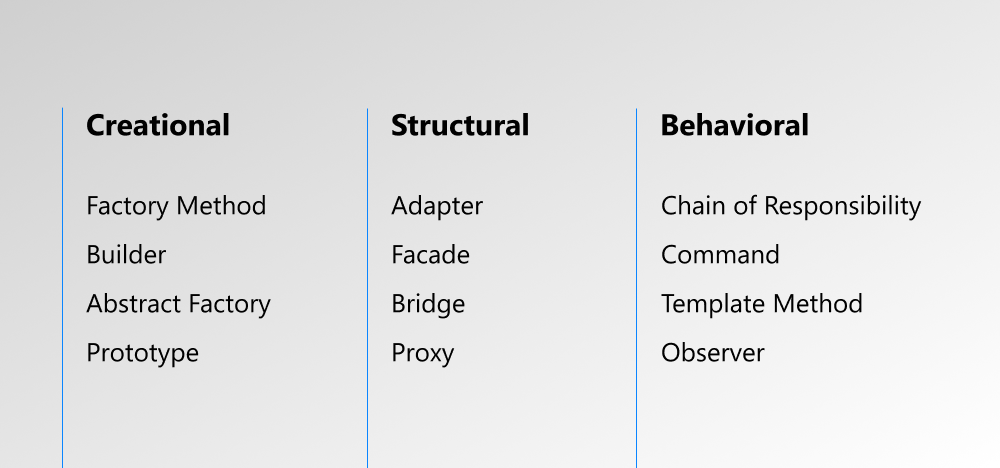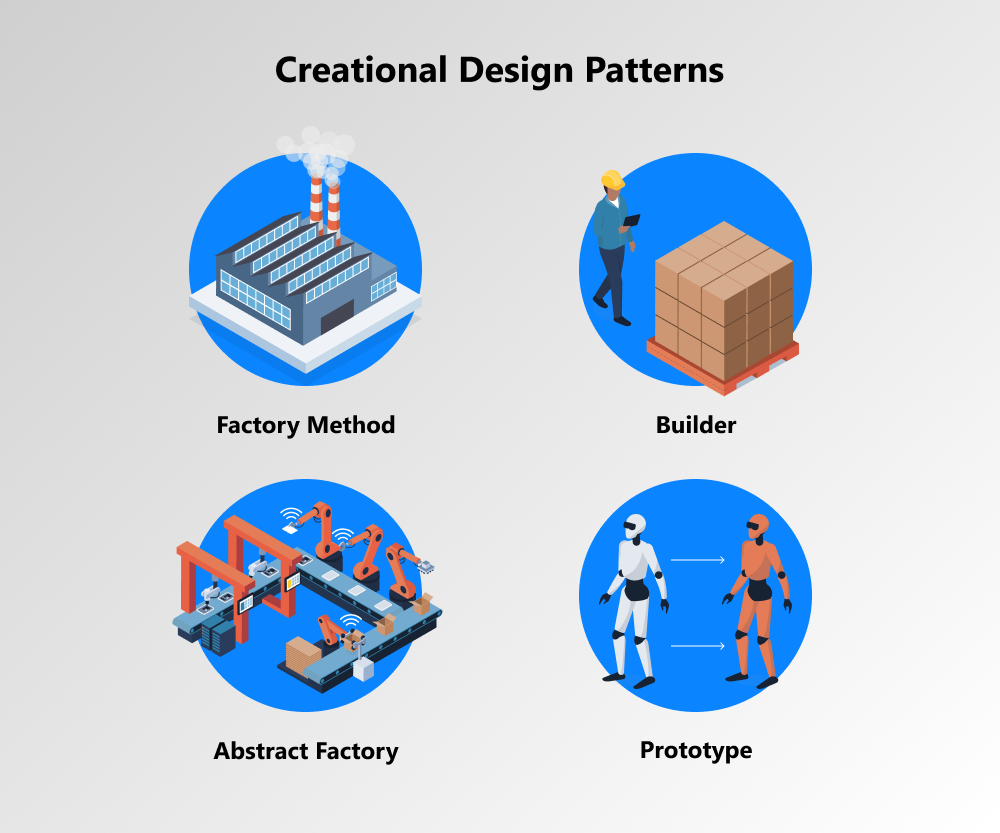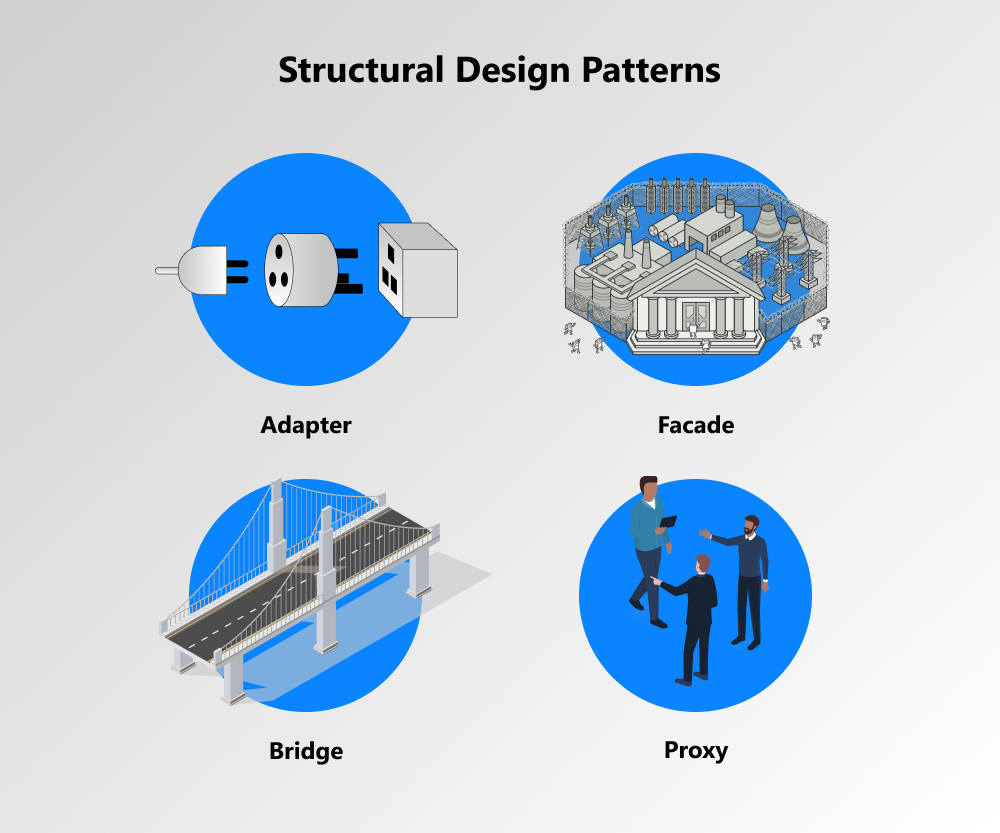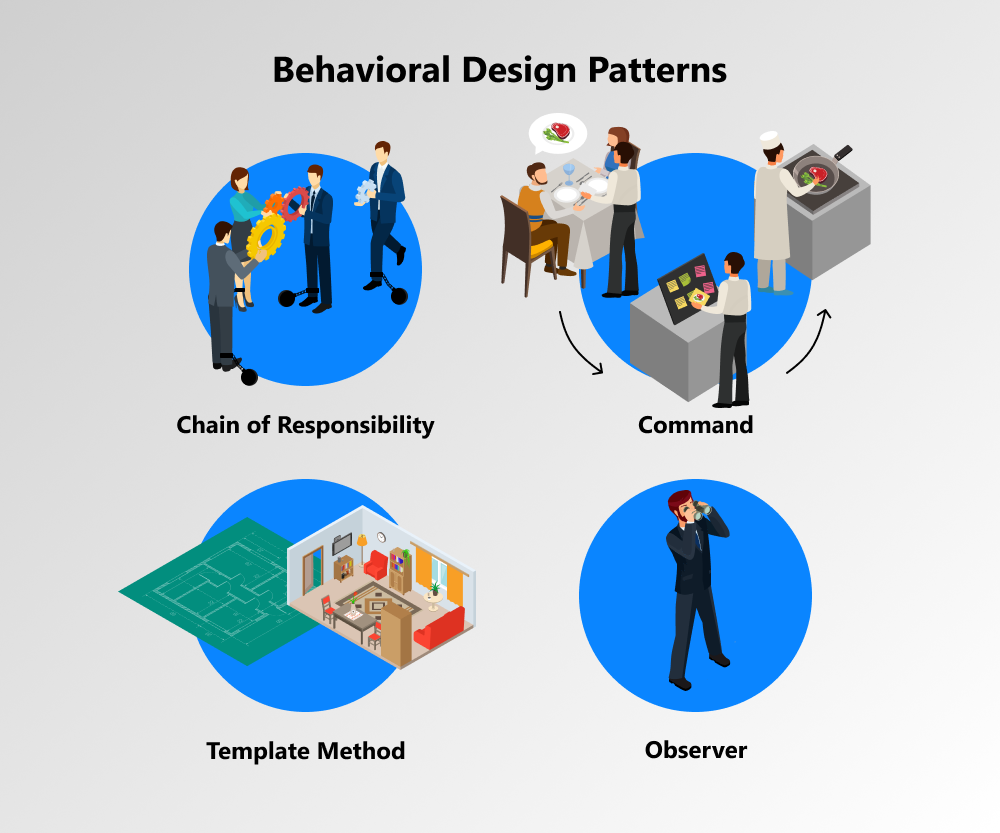There are about 4.4 million applications one can download from the Apple App Store, according to Statista. iOS apps are usually written in Objective-C and Swift, with the latter being one of the most rapidly growing programming languages today. However, developing apps is a tedious job, although programmers don't have to reinvent the wheel because in the majority of cases the most common problems were encountered by other developers earlier, resulting in Swift design patterns.
written by:
Nadezhda Mal
There are about 4.4 million applications one can download from the Apple App Store, according to Statista. iOS apps are usually written in Objective-C and Swift, with the latter being one of the most rapidly growing programming languages today. However, developing apps is a tedious job, although programmers don't have to reinvent the wheel because in the majority of cases the most common problems were encountered by other developers earlier, resulting in Swift design patterns.
Contents
Introduction
Developers write a lot of codes and test them many times to solve common problems and make sure their programs work fine. It is time-consuming sometimes but thanks to iOS design patterns life can get easier for iOS application development companies. In this article, we will discuss design patterns in Swift, their advantages, categories, methods, and answer the question of why it is important to use them in iOS development.
What Are Design Patterns?
A design pattern is a typical solution to a particular problem that occurs in software design. In contrast to off-the-shelf functions or libraries, the builder cannot paste the design pattern into the app because it is not a piece of code. Design patterns are common concepts for solving one or another problem that should be adjusted to the demands of your program.
Design patterns are often confused with algorithms because both of them describe typical solutions to well-known problems. But it is important to understand that the algorithm defines a set of actions that help a developer achieve a goal, while the pattern is a high-level description of the solution. Moreover, this solution can be implemented in two different programs in many ways.
Simply put, algorithms are cooking recipes with clear steps to make a dish, while patterns are drawings that demonstrate the solution rather than steps describing how to implement this solution.
The design pattern usually consists of the following:
- a problem to be solved by the design pattern;
- motivation to solve the problem in a way offered by the design pattern;
- structure of interfaces and classes comprising the solution;
- an example in one of the programming languages (i.e., Swift);
- implementation features in various contexts;
- connections with other design patterns.
Advantages of Design Patterns
Design patterns bring the following benefits:
- Proven solutions. Design patterns already provide out-of-the-box solutions and tell how to implement them. This allows developers to solve their software development problems faster and significantly save time.
- Code reuse or code unification. With design patterns, developers receive typical solutions that have been tested for various bugs and errors. This feature allows them to avoid mistakes when they are working on their apps and programs.
- Common vocabulary. A developer doesn’t need to waste time explaining how to solve the software development problem. It will be enough to name the used design pattern, and you’ll understand what the solution is about.
Classification of Design Patterns in Swift
Design patterns differ by the complexity, scale of applicability to the whole system, and level of detail. Speaking about the patterns used in Swift iOS app development, they are usually divided into three major categories, including:
- Creational
Creational design patterns are responsible for the convenient and safe creation of new objects or even families of objects. They include the following commonly used methods: Factory Method, Builder, Abstract Factory, and Prototype.
- Structural
Structural design patterns are used to compose classes and objects into a larger system. Their task is to simplify the designing process and find a simple method for correlating the objects and the classes. The most common structural design pattern methods include Adapter, Facade, Bridge, and Proxy.
- Behavioral
Behavioral design patterns allow program objects to communicate effectively and safely. The most popular behavioral design pattern methods are Chain of Responsibility, Command, Template Method, and Observer.
What is the Most Popular iOS Design Pattern in Swift?
1. Creational
Factory Method
The Factory Method allows developers to solve the problem of creating objects without defining their specific classes. There is no need to use direct constructor calls (new operators). Subclasses can override the Factory Method to alter the class of objects that will be created. This creational design pattern help programmers avoid strong dependency between the creator and the specific products. They can transfer the product creation code to one place, making it easy to support the code. It also lets the developer introduce new types of products into the software without modifying the existing client code.
Real-life example: Imagine that you're building a house. You need doors, but you won't make them by yourself. You will order the doors at the factory.
Applicability: The pattern can often be found in any Swift code where flexibility is required when creating products.
Identification: The Factory Method can be identified by creation methods that return product objects through abstract types or interfaces. This allows developers to redefine the types of products to be generated in subclasses.
Builder
The Builder allows the developer to create complex objects step by step. Programmers can use the same construction code when producing various types and representations of the objects. It is designed to solve the problem of the Telescoping Constructor anti-pattern. This method gained popularity among iOS developers when SwiftUI, a declarative UI framework, was brought to the table.
Real-life example: Imagine that you've come to McDonald's and ordered a particular product, for example, a Big Mac. The restaurant will make it without additional questions. This is an example of a simple factory. But there are cases where the creation logic can include more steps. For instance, you want a special sandwich from Subway. You have several options for how it will be made. What kind of bread do you want? What sauces will be used? What kind of cheese would you like? The Builder pattern will be used in these cases.
Applicability: This creational pattern is widely used in Swift code, especially when a developer needs to create an object with many possible configuration options.
Identification: The Builder design pattern can be recognized in a class that has one creation method and several methods to configure the created product. The Builder method usually supports chaining (e.g., someBuilder.setValueA (1) .setValueB (2) .create ()).
Abstract Factory
The Abstract Factory provides an interface for creating families of interrelated or interdependent objects without defining their specific classes. The pattern is implemented by creating an abstract Factory class, which is an interface for creating system components (for example, it can create windows and buttons for a window interface). Then a developer writes classes that implement this interface.
Real-life example: When you need doors, you order them at the factory. Imagine that you need various doors, i.e., a wooden one from one store, an iron one from another, and plastic ones from the third shop. Besides, you will need a particular specialist: a carpenter who will make the wooden door, a welder who will work with the iron one, and so on. As you can see, there is a dependency between the doors.
Applicability: The Abstract Factory pattern is often used in Swift code, especially where it is required to create families of products (for example, within frameworks).
Identification: The pattern can be identified by methods that return a factory, which, in turn, is used to create particular products, returning them through abstract types or interfaces.
Prototype
The Prototype design pattern sets the types of objects to be created using a prototype instance and creates new objects by copying this prototype. It allows developers to get away from implementation and allows them to follow the "programming through interfaces" principle. An interface/abstract class at the top of the hierarchy is specified as the return type, and inherited classes can put an inheritor that implements this type.
Real-life example: Prototypes are usually used to conduct different tests before launching mass production of some products. However, prototypes don't take part in any production here. They play a passive role.
Applicability: The Prototype pattern is implemented in the base Swift library through the Cloneable interface.
Identification: The Prototype method is easily identified in the code by the presence of the clone, copy, and other methods.
2. Structural
Adapter
The Adapter structural design pattern is designed to organize the use of the functions of an object that are not available for modification through a specially created interface.
Real-life example: Let's imagine that you have taken some pictures and want to transfer them from your camera to your PC. For this purpose, you need an adapter that is compatible with the ports on your computer. In this case, you can use a card reader that acts as an adapter.
Applicability: The Adapter design pattern can often be found in Swift code, especially where it is required to convert different data types or when classes should work together with different interfaces.
Identification: The Adapter pattern receives a convertible object in the constructor or through the parameters of its methods. The Adapter methods are usually compatible with the interface of one object. They delegate calls to the nested object, before making the call parameters in the format supported by the nested object.
Facade
The Facade structural design pattern allows programmers to hide the complexity of a system by reducing all possible external calls to a single object that delegates them to the corresponding objects in the system.
Real-life example: How do you turn on your computer? You just press the power button, right? That's what you think as you use a simple interface provided by your computer to give you access. You don't know how many things take place inside. The facade is a simple interface for a complex subsystem.
Applicability: The pattern is often found in client applications written in Swift that use facade classes to simplify working with complex libraries or APIs.
Identification: The Facade pattern is identified in a class that has a simple interface, but delegates the bulk of the work to other classes. Facades most often monitor the life cycle of objects of the complex system.
Bridge
The Bridge structural design pattern is used in software development processes to separate abstraction and implementation so that they can change independently. The Bridge pattern uses encapsulation, aggregation, and can use inheritance to separate responsibilities between classes.
Real-life example: Let's imagine that you have a website with different pages. You want to allow users to change their theme. What are you going to do? Will you create multiple copies of each page for each theme? Or just a separate theme for the user to choose from? The Bridge pattern allows you to do the second option.
Applicability: The Bridge pattern is especially useful when you have to create cross-platform applications, support several types of databases, or work with different providers of similar API (for example, cloud services, social networks, etc.).
Identification: If the program clearly identifies the "control" classes and several types of "platform" classes, where the control objects delegate execution to the platforms, then we can say that you apply the Bridge design pattern.
Proxy
The Proxy structural design pattern provides an object that controls access to another object by intercepting all calls (i.e., acts as a container).
Real-life example: A credit card can be a proxy for a bank account, which, in turn, is a proxy for a wad of cash. Both implement the same interface: you can use them to make a payment. You are happy because you don't need to carry a bundle of cash around. A salesperson feels great because the income is sent to the shop's bank account directly without the necessity to go to the bank to surrender receipts.
Applicability: The Proxy pattern is used in Swift code when it is necessary to replace a real object with its proxy. Moreover, it should be invisible to the clients of the real object. This will allow developers to perform some additional behaviors before or after the main behavior of the real object.
Identification: The proxy class most often delegates all real work to its real object. Proxies often monitor the life cycle of their real object by themselves.
3. Behavioral
Chain of Responsibility
It is used to organize responsibility levels within the system.
Real-life example: For example, you have set three payment methods (A, B, and C) for your bank account. Every account has a different amount of money. You have $100 on the A account, $300 on the B account, and $1,000 on the C account. You prefer to use your accounts in the following order: A, B, and C. You are trying to order something that costs $210. Using this design pattern, you will check the A method for the possibility of paying. If successful, the payment will be made, and the chain will break. If not, the B method will be checked, and so on. A, B, and C are chain links, while the whole event is a chain of responsibilities.
Applicability: The pattern is not very common in Swift since it requires a chain of objects, for example, a linked list.
Identification: It can be identified by the lists of handlers or checks through which requests are passed. Especially if the order of handlers is important.
Command
The Command behavioral design pattern is used in object-oriented programming to represent an action. The command object contains the action itself and its parameters.
Real-life example: Imagine that you order food in a restaurant. You (or Client) ask the waiter (or Invoker) to bring food (or Command), and the waiter simply forwards the request to the chef (or Receiver), who knows what and how to cook.
Applicability: The pattern can often be found in Swift code, especially when you need to postpone the execution of commands, queue them up, as well as keep history, or cancel actions.
Identification: The Command classes are built around a single action and have a very narrow context. The Command objects are often sent to the handlers of events of GUI elements. Almost any undo implementation uses the principle of commands.
Template Method
The Template Method defines the basis of the algorithm and allows descendants to override some steps of the algorithm without changing its structure as a whole.
Real-life example: Let's say you are going to build houses. You will make the following steps: foundation, carrying up walls, roofing, and so on. The order of the steps never changes. You will not erect walls until the foundation is ready. However, each step can be modified: for example, you can use wood, bricks, or concrete to erect the walls.
Applicability: The Template methods can be found in many Swift library classes. Developers create them to allow customers to easily and quickly extend standard code using inheritance.
Identification: The class makes its descendants implement the step methods, but it implements the structure of the algorithm. by itself.
Observer
The Observer behavioral design pattern allows developers to specify a subscription mechanism to inform numerous objects about any events that arise to the object they are observing.
Real-life example: If you subscribe to a magazine or newspaper, you won't need to go to the shop every day to check whether the latest issue is available. You will be able to receive new issues of your favorite magazine or newspaper to your mailbox directly. The publisher, in turn, will be able to maintain a list of subscribers and monitor which editions are in demand. You can leave the list at any time you want to stop the publisher from sending new issues to you.
Applicability: The Observer method pattern is often used in Swift code, especially in the GUI components. It lets individual components react to the events taking place in other components.
Identification: The Observer method can be identified by the subscription mechanism and methods of notification that call the software components.
 Last Word
Last Word
So, we've taken a look at the top design patterns in Swift used for iOS development. It's impossible to say what is the best iOS design pattern since every team chooses instruments depending on their tasks and goals. In addition, design patterns are divided into three categories and have different methods helping programmers to solve problems with every iOS application. Using these tools allows developers to create fully secure and functional apps that are easy to maintain and modify. iOS programmers should definitely include design patterns in their skillset as they accelerate and simplify app development, ensure high quality of their codes, as well as optimize the whole process.
If you want to learn more about the iOS design pattern you'd better use in mobile and web development, please contact our Support Team or visit our website.

Contacts
Feel free to get in touch with us! Use this contact form for an ASAP response.
Call us at +44 151 528 8015
E-mail us at request@qulix.com







 Last Word
Last Word

